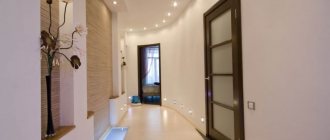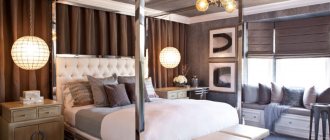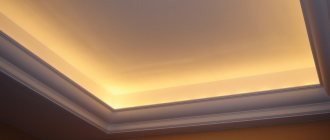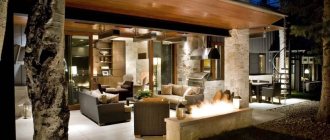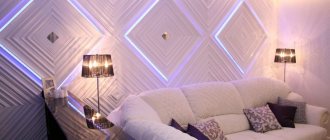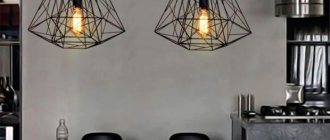Floor lamps: a little history
Floor lamps have appeared in interiors a long time ago. Historically, they are attributed to the times of Ancient Greece and Rome. The origin of the word floor lamp is associated with the French language, translated meaning torch.
Initially, the structure was mounted on the wall. Over time, for convenience and increased mobility, a tripod was used, which was carried when necessary. A torch was used for lighting, later replaced by a gas lantern. With the development of new technologies, electric floor lighting has come to replace it.
Vintage floor lamps
Initially, wood and stone were used as materials for floor lamps. Forged metal structures were popular. The execution was very diverse: from the usual simple to complex vases or interesting columns.
Floor lamps in the interior: advantages
Floor lamps are widely used in interiors due to a number of advantages that consumers enjoy:
1. A floor lamp is a mobile structure, for its placement in a room there is no need to perform preliminary installation work, for example, attaching the structure to the wall or laying new wiring. To install the lamp and turn it on, it is enough to move the structure to the part of the room needed for lighting. The main requirement is the availability of a source of electricity.
The floor lamp can be easily rearranged
2. Using a floor lamp, you can easily divide the room, which will allow you to perform zoning in one part of the room.
Zoning with a floor lamp
3. Using floor lamps in the interior of the living room, you can illuminate only the necessary part of the area and thereby save on utility bills.
4. The floor lamp allows you to create a directed beam of light, which creates convenience for the user.
Modern floor lamps have amazingly beautiful shapes, are made in a certain style and can decorate a room, bring comfort and coziness to it, and radically change the visual perception of space.
Floor lamps: design features
Floor lamps or floor lamps are a structure consisting of a stable base and a rod on which the light source is attached. The rod is relatively large. Most often, its height is from 1 to 2.5 meters.
Floor lamp design
The most familiar and popular designs are a floor lamp with a lampshade. Theoretically, a lampshade should not be required. The lighting fixture may not be covered by anything, but the lampshade gives the design an aesthetic appeal and supports the style of the interior.
Notes
| : Incorrect or missing image | To improve this article it is desirable:
|
| Fluorescent | Fluorescent lamp (compact fluorescent lamp) • Cathodoluminescent lamp • Induction lamp • Mercury lamp • Black light lamp |
| Gas discharge | High Intensity Lamps • Neon Lamp • Sodium Discharge Lamp • Xenon Flash Lamp • HID Lamps • Electrodeless Lamp • Plasma Lamp • External Electrode Plasma Lamp |
| Electric arc | Carbon arc lamp • Xenon arc lamp • Yablochkov candle • Metal halide lamp |
| On combustion | Luchina • Torch • Candle • Oil lamp • Gas lamp • Acetylene lamp • Kerosene lamp • Heat grid • Drummond light • Argand lamp |
| Semiconductor | LEDs (LED lighting • LED lamp • organic LED • blue LED • white LED) |
| Others | Sulfur lamp • Chemical light source • Tritium backlight |
| Types of luminescence | Electroluminescence • Chemiluminescence • Bioluminescence • Radioluminescence • Sonoluminescence • Thermoluminescence • Cathodoluminescence • Photoluminescence (fluorescence • phosphorescence) • Triboluminescence • Candoluminescence • Cherenkov radiation |
| Lighting design | Spotlight • Chandelier • Floor lamp • Sconce • Ilyich bulb • Lantern (street • pocket) • Explosion-proof lamp • Plasma lamp • Electroluminescent wire • Lava lamp • Optical fiber • Energy saving lamp |
Floor lamps: lampshade material
A variety of materials can be used for the lampshade:
1. Most often, fabric lampshades are used, both simple and with ruffles, fringe or other decorations.
Floor lamp with fabric lampshade
2. Plastic and ceramics can be used for the lampshade.
Floor lamp with plastic lampshade
3. Less common are paper lampshades.
Paper lampshade
4. The glass lamp looks visually beautiful and creates high-quality diffused light.
Lamps with glass shade
5. Modern metal lampshade designs are used for interior decoration. The whimsical shadows they create create an elegant twilight.
Floor lamp with original metal lampshade
Floor lamp: types of lighting
Depending on the material used and the design of the lampshade, the lighting of the space differs. It can be bright light that hits the eyes or soft, diffused penumbra. Depending on the quality of lighting, the following floor lamps in the living room are distinguished (types):
1. Diffused lighting is provided by floor lamps, the lampshades of which are made of light-transmitting materials: fabric, plastic. In this case, the light is soft and helps create a cozy atmosphere.
Floor lamp with diffused light
2. Directional floor lighting helps to create lamps with a movable design for mounting the light source. They are convenient to use to create a directional glow when reading or performing precise work.
Floor lamp with adjustable light direction
3. Reflected light is produced when the emitted light is directed at the surface of a wall or ceiling and a reflected beam is used for illumination. In this case, the entire room is illuminated at once.
Modern solutions
Devices in which the lighting sources are hidden look interesting. Until you turn on such a floor lamp, it will look like a sculpture or monument. Stylized lamps are also worthy of attention. You can immediately see from them which style direction they belong to. Due to the presence of such products on the market, it is difficult to make a mistake and buy a model that does not harmonize with the situation. Another merit of modern designers: their departure from classical norms made it possible to solve the problem of unsteadiness. Nowadays you can find a very stable floor lamp not on one thin leg, but on a thick one or several at once. In contrast to such reliable and safe options, fire hazardous ones are also being implemented. These include models that have an elongated glass column and a light source. The first time such a lamp falls, it will break and, most likely, become a source of fire.
IMPORTANT. The lampshade is a beautiful detail typical of floor lamps. If it is made of unbreakable material - leather, fabric, plastic or metal - it can be regarded as additional protection for the light bulb.
Classification of floor lamps by design features
Modern floor lamps differ in styles, materials, and design features. But you can still classify them according to some characteristic features:
1. Lampshades closed at the top and bottom, the so-called isolated lighting, create diffused soft light. Often used in the bedroom or living room, where they create a cozy atmosphere in a small area.
Floor lamp with closed lampshade
2. Lampshades that are not closed at the top and bottom are used to create a stream of reflected light. It does not dazzle and is pleasing to the eye. Such lamps can be installed in any room. Reflected light helps make the room proportional.
Lampshade open at top and bottom
3. Combined floor lamps create both diffused lighting through the lampshade material and directed lighting due to the absence of material above and below the lighting fixture.
Combined floor lamp
4. Decorative lamps have more of an aesthetic function than they serve to illuminate the room. Made in the form of vases, sculptures, and intricate metal structures, they decorate the room, and the presence of a light source is designed to emphasize the uniqueness of the design.
Decorative floor lamp
5. Less common are office floor lamps. They are made in a strict office style or hi-tech.
Floor lamp in high-tech style
The classic style lamp is most often found in the interior of a room. It consists of a small round or rectangular base, an upright stand and a lampshade attached to the top. All parts of such a floor lamp are fixedly fixed.
Classic style floor lamp
Balance and brightness
The main thing is to achieve balanced lighting throughout the room. You need to understand which zones should be highlighted and which are better left in the shade. If we are talking about a bedroom, then maximum light should be concentrated on the bedside tables, and the general background should be dimmer.
In the living room, you should install several lamps near the sofa, coffee table and near shelves with books. This is the only way you can get harmonious and proper lighting throughout the house.
Cylindrical floor lamps for a bright living room
Modern and stylish lamps for illuminating tables and TV. Chris Snook's idea
A tall floor lamp complete with a table lamp perfectly complements the design of the room. Whitney Lyons idea
Simple and effective bedroom lighting creates visual symmetry. Project Jessica Bennett Interiors
Lamps in the corners provide symmetrical lighting for the dining room. Idea by Glenn Gissler Design
An elegant floor lamp emphasizes the golden finish of the interior. Design by Klang & Associates
Gorgeous living room in milky blue tones with a stylish accent in the form of a metal lamp. Project Ziger/Snead Architects
A space-style lighting fixture for an unusual living room. Idea by Peter A. Sellar
This unusual lamp is a real work of art. Design by Adrienne DeRosa
Floor lamps: area of application
Like any mobile portable structures, floor lamps are installed in places where additional or local lighting is required. Decorative lamps can be used as decorations. Most often, floor lighting is used in the following cases:
1. Traditionally, floor lamps are installed in living rooms. In these rooms, not only overhead lighting is in demand, but also floor lighting, which can be used to locally illuminate the area near the coffee table. Decorative lamp is used as part of the decor.
Floor lamp as part of the living room decor
2. Soft diffused light from a floor lamp fits well into the bedroom and is considered a good alternative to a wall sconce. Can be installed by the bed and used when reading literature.
Floor lamps in the bedroom
3. As additional lighting, a floor lamp can be installed in the hallway. When choosing a lamp, you need to focus on the size of the room. In a small room, a large floor lamp will look inharmonious and reduce the size of an already small area.
Floor lamp in the hallway interior
Natural motifs for your interior
Everyone has a penchant for renewal. In this case, we usually resort to rearranging the room. But think about it: moving heavy and massive furniture is not so easy! What if you change the lighting angle for a change? After all, this will also give a certain change in the picture. And you must agree, rearranging the lamp is much faster and easier.
A beautiful and elegant floor lamp slightly smoothes out the space of the room. Heather Merenda idea
Contrasting floor lamps distract attention from the monotonous design of the living room. Project Peg Berens Interior Design
A fabulous lampshade in the shape of a bird's nest brings harmony with nature into a modern interior
Small lamps are an advantageous solution for a home library or office, because this is where additional, local lighting is needed. In addition, they can be placed in the most inaccessible places where other lighting devices cannot be placed.
Convenient local lighting above the sofa is always suitable for comfortable reading
Tall lamps on black legs create amazing visual balance in the living room. Project W Design Interiors
Bedside table lamps for local lighting of the bedroom. Idea Rachel Reider Interiors
Black and white living room with lighting fixture stylized as a flower. Polly design
Comfortable lighting for home office and library
A small lamp in the corner for extra light. Andrew Snow Photography Project
A lamp on a high leg for an ultra-modern living room. Idea by MN Design/Mauricio Nava
Spacious house with snow-white lamps for soft light. Design by Butler Armsden Architects
Living room in dark shades with a fashionable lamp in metallic tones. Project Mc Conigal Signature Homes
Styles of floor lamps
Floor lamps fit well into any style. When choosing a lighting device, two approaches are used:
1. The lamp must match the design style of the room and fit harmoniously into the decor.
The floor lamp fits harmoniously into the interior style
2. The style of the lighting fixture can be contrasting with the design of the room and stand out.
Floor lamp as a bright accent in the interior
To decorate and illuminate rooms, floor lamps made in the following styles are most often used:
1. The classic style is characterized by lush design, symmetrical shapes, and rich decor. It would be appropriate to use fabric draperies on the lampshade, forged decorations, and stucco on the counter.
Openwork floor lamp in a classic interior
2. For a minimalist style, laconic lamps are suitable, not necessarily covered with shades. LED lamps disguised in the console look good. Recently, the retail chain has been offering a large number of uniquely designed lighting fixtures made from one lamp, not covered by a lampshade. These non-bulky designs are suitable for small spaces. The classic black or white color is most consistent with the style. This lamp cannot supply enough light for high-quality lighting, but it can easily solve the issue of backlight or background light.
Laconic floor lamp
3. Rooms decorated in a loft style will be decorated with a lamp that matches the style of a street lamp or with incandescent lamps with uncovered shades. Of course, the main emphasis is on the use of glass and metal.
Floor lamp in loft style
4. A floor lamp in a retro style must have details from the last century, reminiscent of models familiar from grandmothers’ interiors.
Retro style floor lamp
Varieties
Floor lamps are divided according to the following principles:
- material of the floor lamp, base and column;
- dimensions (height, massiveness);
- installation method (on the floor or on a horizontal surface);
- the presence of additional elements (for example, shelves);
- control method (presence and location of power buttons, possibility of remote activation and configuration);
- the ability to adjust the power of the light flux (this is possible with a dimmer);
- leg shape (straight, curved, flexible, articulated, tripod);
- presence and number of lampshades;
- type of lighting (accent, background, main).
There are also models with directed, reflected and diffused light. The classic version of floor lamps is a source of scattered rays. If the rotation and tilt of the lamp can be changed, then we are talking about a directional type. In the reflected form, it is necessary to include walls, ceilings, floors or other interior items: with their help, rays spread, refract and are reflected.
Devices are produced that are characterized by 2 or even 3 lighting methods at once. Typically, this opportunity opens up if there are additional lampshades: the central one sends scattered or reflected rays, the side one sends directed ones. This design is often shaky, but it is convenient for reading and doing handicrafts.
Material of manufacture
Material is closely related to style. The classical direction is characterized by the use of fabric and paper in the manufacture of lampshades, for country - wood and metals, for Provence - fabric (usually richly embroidered or decorated with ribbons), for high-tech - metal and glass. Glass and crystal mosaic lampshades often hint at Tiffany, while those created from twigs and branches refer to eco-style and oriental traditions. Japanese and Chinese styles are also visible in terms of decor. These movements are characterized by minimalism. The base is very often made of wood (classic, oriental, eco-style, country), stone, metal (high-tech, art deco), clay. Columns are made from clay, willow twigs, metal, glass, plastic, rattan.
Dimensions
Helpful notes regarding sizing:
- a tall floor lamp is not suitable for a small room with a low ceiling (it will begin to serve as central lighting, but the room will not be filled with light as evenly as from a chandelier);
- a low floor lamp will get lost among massive furniture;
- in spacious rooms with really high ceilings, floor lamps over 1.5 m high are installed;
- one and a half meters and slightly lower are suitable for the area next to an armchair, table, bed;
- small models - about a meter or less in height - have a decorative function (they are not suitable for working or reading, in these cases you need to use additional lighting sources).
You should also be careful when purchasing a tall floor lamp, whose very flexible and thin column ends in 1 large lampshade or many small ones. This design is too shaky; its direction-changing leg will eventually begin to hold the lampshades worse (it will begin to sag under their weight).
Choosing a floor lamp
Despite its apparent simplicity, the choice of a floor lamp must be made intelligently, while focusing on many indicators. It is generally accepted that small floor lamps should be installed in small rooms. In addition to matching the style and volume of the room, it is recommended to take into account the technical characteristics.
The modern design of the lamp not only fits well into the room, but can control the space and change its size:
1. A tall lamp rod makes the room visually taller.
A high rod lamp will make the room visually taller
2. On the contrary, a low structure pushes the walls apart. Light directed upward increases height.
3. In a small room, a bulky structure will visually narrow the space.
4. Depending on the purpose of the lamp, choose a design with diffuse lighting or directional lighting, if you need to do handicrafts or read literature.
A lamp with directional light is suitable for reading
5. If zoning of the room is planned, install lamps with shades that direct light downwards.
6. If a floor lamp is used as additional lighting, choose a lamp with a beam directed upward into the room, using reflected light.
Lamp with overhead light
7. A lamp made of elegant, thin structural elements will not visually clutter the room.
8. When using a floor lamp in a small room, designers advise using a lamp of the same color as the tone of the walls, in this case the space will not be visually reduced.
Lamp to match the walls
Floor lamps in the living room (types)
Structurally, lamps can be made in several designs. The most commonly used design is a translucent lampshade, which is used to create diffused light. It is rare, but there are floor lamps in the interior without a lampshade; they are used for rooms in minimalist styles.
Floor lamp without shade
Floor lamps can be a small but stable base with a rod and lampshade. See photos of floor lamps in the living room interior. The design may have a horizontal platform located on the middle part of the rod and used as a table. Often there is a single console. A tripod-shaped design is allowed.
Functional floor lamp with table
The lamp can be in the form of a figurine, vase or sculptural composition, in this case it forms the main detail of the interior.
Sculptural floor lamp
Decorative floor lamps
Today's lamps differ from the designs familiar from childhood. Modern light sources in the form of LED or halogen lamps have changed traditional ideas about floor lamps. The lampshades acquired previously unused shapes: spheres, cubes, balls, hemispheres. Can be made in the form of buds, blossoming flowers. Interesting are the designer's floor lamps, which consist of many lamps located in different directions.
Designer floor lamp
The support may not be a straight upward rack, but a bizarrely curved console, a section of a spiral, or a structure reminiscent of wood. Pay attention to the photo of floor lamps in the living room interior. A floor lamp structurally connected to a coffee table looks interesting.
Floor lamp with coffee table
When choosing a floor lamp for a room, they are guided by the already installed lamps and the style of their execution. For example, a floor lamp with crystal pendants is most successfully combined with a crystal chandelier.
Modern author's works surprise with their unusual execution and combination of different styles. There is still a demand for lamps that are not only beautiful, but also functional, when the lighting device can be located at different adjustable heights. By changing the angle of inclination, a floor lamp can change the quality of illumination of a surface or room.
Floor lamp with height adjustment
Floor lamps are modern designs that can be matched to any room decor style. They are not only used for additional illumination of a room or special illumination of one of its zones. They can decorate the interior, add a new mood to it, and be the finishing touch when creating a style.
The floor lamp has now received its next birth in the interiors of modern apartments. By using new sources, light can be supplied to the most remote places in space.
What types of floor lamps are there?
There are three types of floor lamps:
- classic models;
- arc lamps;
- ceiling lamps.
Each option is different in both form and function. Many people prefer models with a reading lamp that illuminates the ceiling.
Note: when choosing a shape, the parameters of the room and the style of its equipment are important.
Classic floor lamps
Classic floor lamps consist of a leg, a long straight base and a lampshade, for example made of fabric. They allow you to create beautiful, light islands and divide up space in rooms. Classic floor lamps are also used to enrich the style with another decorative element. This is a solution that hotels use to transform their lobby into a place that promotes relaxation. Classic floor lamps work great in the home.
Arc lamps
Arc lamps are distinguished primarily by their curved base. The leg slides under the sofa, the base wraps stylishly around the backrest, and the light falls from above (or slightly to the side) onto the pages of a crime novel. This way you don't have to constantly turn the book towards the light. Yes, it will be easier to read this way.
Ceiling floor lamps
The lamps that illuminate the ceiling rise straight up, like a classic standing model. However, the light is not directed to the side and down, but towards the ceiling area. When the lamp is bright, the light reflects and spreads softly around. But this option is still not comfortable enough for reading. Designers also noticed this feature, so a lamp illuminating the ceiling can be combined with a reading light on a flexible arm.
